|
Posted: 17 Jan 2014 07:56 AM PST
A message purportedly written by Ayman al Zawahiri's top representative in Syria, Abu Khalid al Suri, was posted on jihadist websites yesterday. The message has been translated by the SITE Intelligence Group, which notes that it "could not be authenticated." Therefore, we do not know if this message is really from al Suri.
Last year, Zawahiri named Abu Khalid al Suri (whose real name is Mohamed Bahaiah) as his arbiter in the leadership dispute between the Islamic State of Iraq and the Sham (ISIS) and the Al Nusrah Front. Al Suri was one of Osama bin Laden's most trusted couriers in Europe prior to the 9/11 attacks. He was imprisoned in Syria but freed after the uprising against Bashar al Assad's regime began. The Long War Journal has reported that he is actually a founding member and senior leader in Ahrar al Sham, an extremist group that has fought alongside al Qaeda's two official branches.
The missive is directed at ISIS, the unruly al Qaeda affiliate that is currently at odds with the Al Nusrah Front (another branch of al Qaeda), the Islamic Front (Abu Khalid al Suri's Ahrar al Sham is a key party within the front), and other Islamist parties.
If the message is indeed from Abu Khalid al Suri, it is yet another example of how senior al Qaeda leaders and ideologues connected to the network have repeatedly implored ISIS to to settle its differences with other jihadists.
The author argues that the spilling of Muslim blood is what caused the jihad in Algeria (in the 1990s) and elsewhere to fail. He warns that the only beneficiary of the infighting will be the Assad regime.
The writer also openly worries that the actions taken by ISIS are jeopardizing the jihadists' ability to build popular support. The infighting "leads to the weakness of the fronts and the advance of the regime and a return to square one, but with the animosity of the mujahideen and a loss of the popular cradle, and this may lead to them being repelled by the Islamic project," SITE's translation reads. In addition, the "behavior of arrogance toward the rest of the mujahideen and the Muslim masses is not part of the path of the people of empowerment nor in its name."
The writer tells ISIS that it should not portray its deeds as being consistent with the advice of senior al Qaeda leaders and ideologues. Here is a key paragraph from SITE's translation [emphasis added]: What we hear today of crimes and incorrect practices being committed under the name of jihad and establishing the Islamic State, and being attributed to the like of the Sheikhs of Jihad such as Sheikh Usama bin Laden, may Allah have mercy on him; Sheikh Ayman al-Zawahiri, may Allah preserve him; Sheikh Abdullah Azzam, may Allah have mercy on him; Sheikh Abu Musab al-Suri, may Allah release him, and Sheikh Abu Musab al-Zarqawi, may Allah have mercy on him, who spent their life in jihad in the cause of Allah, Allah's name, is away from the correct method. So my words to you are the words of one who spent his life with those prominent men and knew them well, for they are innocent of what is being attributed to them, like the innocence of the wolf from the blood of the son of Jacob. Do not be tricked by the confusion of those who confuse nor the news of the liars.
The three spots where I've added emphasis are interesting.
First, the writer mentions Abu Musab al Suri (Mustafa Setmariam Nasar), who is a major al Qaeda ideologue and Abu Khalid al Suri's longtime companion. The phrasing "may Allah release him" means that the author believes Abu Musab al Suri is still imprisoned. According to other sources, Abu Khalid does believe that his compatriot is in custody. This is interesting because there have been credible reports that Abu Musab was let out of prison in the wake of the Syrian uprising. We've cited those reports at The Long War Journal but careful readers will note that we added a caveat (see the note at the bottom here, for example), because we can't be sure one way or the other.
Second, the author says that the actions of ISIS should not be attributed to the memory of "Sheikh Abu Musab al Zarqawi, may Allah have mercy on him." This is rich given that Zarqawi's barbarism is what became a major liability for al Qaeda in Iraq. Over time, Zarqawi and his successors did do a better job of coordinating with other jihadist forces in some ways, but al Qaeda in Iraq's (AQI) brutality was a major reason why key tribes and local forces in western Iraq turned against the group, sided with American forces during the "surge" and drove back AQI's territorial gains for a time. Unfortunately, much of that progress has been undone.
Third, the writer says that his words "are the words of one who spent his life with those prominent men [al Qaeda's leaders and senior jihadists] and knew them well." This is entirely consistent with Abu Khalid al Suri's biography.
In the end, the author calls "upon the emirs of the Islamic State in Iraq and the Sham and the brother emigrants and supporters from among the soldiers of State to repent to Allah and return to His matter and adhere to His Shariah." Other senior jihadists have repeatedly called on ISIS to submit to a common sharia court to settle the jihadists' differences.
|
|
Posted: 17 Jan 2014 09:20 AM PST
Islamist militants detonated explosives along a natural gas pipeline in Egypt's Sinai Peninsula today. The latest attack took place near the "a village in central Sinai called el-Riysan," the Associated Press reported.
Thus far, no casualties have been reported. According to al Masry al Youm, the targeted pipeline supplies gas to industrial areas in the Sinai, including a cement factory linked to the Egyptian army.
The last attack on a gas pipeline in the Sinai occurred late on Dec. 31. Since July 3, there have been more than 275 reported attacks in the Sinai Peninsula, most of which were carried out against Egyptian security forces and assets, according to data maintained by The Long War Journal. Gas pipelines appear to have been attacked only twice during that time, on July 7 and Dec. 31. On July 23, Egyptian media outlets reported that a gas pipeline was attacked, but Egypt's Petroleum Ministry denied the allegations.
Since February 2011, a Sinai gas pipeline that supplied Israel and Jordan with gas has been attacked more than a dozen times. In February 2012, al Qaeda emir Ayman al Zawahiri lauded "the heroes who blew up the gas pipeline to Israel" in a message released to jihadist forums.
Approximately five months later, Ansar Jerusalem (Ansar Bayt al Maqdis), the dominant jihadist group in the Sinai, released a video in which it took responsibility for 13 of the attacks. "[I]f you [the Egyptian government] continue exporting gas to the Zionist enemy [Israel] and continue in your betrayal, then we will resume bombing the pipelines once again, but bigger this time," an official said in the video, according to a translation by the SITE Intelligence Group. In the video, Ansar Jerusalem showed its fighters preparing and planting explosive devices along the gas pipeline, while audio from Zawahiri's February speech played.
In April 2012, Egypt ended a deal that saw it provide gas to Israel, according to press reports.
|
|
Posted: 17 Jan 2014 07:47 AM PST
Over the past few weeks, the news has been rife with reports of infighting between the Islamic State of Iraq and the Sham, an al Qaeda affiliate, and other Islamist groups in Syria, including al Qaeda's other Syrian affiliate, the Al Nusrah Front. The Syrian Observatory for Human Rights, an opposition activist observer group, claimed yesterday that 1,069 people have been killed in clashes between rival Islamist groups from Jan. 3 to Jan. 15 in northern and eastern Syria. That figure includes some 130 civilians, as well as 312 ISIS fighters and 608 combatants from what the SOHR calls "the Islamist and non-Islamist rebel battalions."
During this same time period, the forces of President Bashar al Assad have been able to capitalize on the disarray and make gains, particularly around Aleppo, after the ISIS withdrew from certain areas. The rebel infighting is a boon to regime forces and clearly detrimental to the overall strength of the Syrian opposition.
The dynamism of this conflict within a conflict has made it difficult to follow, as reports of shifting allegiances among the ranks of rebel fighters complicate the picture. In its broad outlines, the fighting among the Islamist groups in Syria appears to constitute a general reaction against the brutal excesses of the ISIS. The apparent triggering event for the clashes was ISIS' alleged torture and murder of a Syrian doctor affiliated with the Islamist group Ahrar al Sham, which is part of the largest coalition of Islamist fighters in Syria, the Islamic Front, formed in November. Since that incident, ISIS has battled intermittently with various Islamist groups, including the Islamic Front, the Al Nusrah Front, the Ahrar al Sham, and others, such as the newly-formed Muhajideen Army.
The Al Nusrah Front's dispute with the ISIS epitomizes the complexity of the disagreements within the jihadist factions. While the emirs of the Al Nusrah Front and the ISIS have been at odds since last year when the ISIS attempted to put Nusrah under its banner, their rivalry has not led to open warfare. But the ISIS' heavy-handed tactics and refusal to submit to combined sharia, or Islamic law, councils, have brought the two groups to blows in some areas. Most recently, Al Nusrah lambasted the ISIS for executing Nusrah's emir for Raqqah. But even while berating the ISIS, Al Nusrah has offered an olive branch, calling for the group to submit to sharia councils with other Islamist units.
Yet at the same time, ISIS seems to be cooperating and even collaborating with the Islamist groups in various theaters across the country. As Islamist fighters, they share the same goals and a common enemy in the Assad regime.
Given the mix of infighting and cooperation between the Islamists, as well as attempts by the Al Nusrah Front to mediate the conflict and a hesitancy by the Islamic Front to openly declare war on the ISIS, at the moment the current internecine warfare is a complicated affair.
The following is a chronology of the recent internecine battle, including [in italics] instances of cooperation or at least toleration between the ISIS and some of the Islamist groups against which it has also fought:
Jan. 1: The SOHR reported that its network of sources is increasingly being threatened by Islamist extremists, but declined to identify them. They were later identified as the ISIS.
Jan. 2: The Syrian National Coalition charged that the ISIS is linked to the Assad regime and serves its interests. An opposition activist group said the body of a British doctor who had been allied with the Islamic Front's Ahrar al Sham but executed by ISIS was recently handed over in a prisoner exchange. The Islamic Front demanded that the ISIS perpetrators be brought to justice by a sharia court for the doctor's death. ISIS released a video clip on the creation of an Islamic state and Osama bin Laden blessing its predecessor group ISI, and the Al Nusrah Front released a lengthy video on its joint operation with the Islamic Front and the Fajr al-Sham Islamic Movement in the capture of an Aleppo hospital.
News emerged that ISIS had taken over Fallujah and Ramadi in Iraq over the past few days.
Jan. 3: A mass demonstration against both the ISIS and the Assad regime took place in Aleppo city. ISIS clashed with rebel groups in various locations in Aleppo province. The Islamic Front and the Syrian Revolutionaries Front called on ISIS to leave the town of Atareb in Aleppo. The Islamic Front denounced ISIS crimes, and the Mujahedeen Army declared ISIS an enemy. Islamist brigades sent reinforcements to the ISIS-controlled Bab al-Salama border crossing by Azaz city. In Idlib, ISIS forces fired on a demonstration and sieged several field clinics.
Jan. 4: The Al Nusrah Front released video of leader Abu Muhammad al-Julani' conducting a battlefield tour in Aleppo. The ISISclashed with various rebel groups in Aleppo, and an ISIS commander is said to have been killed in Azaz. ISIS warned rebels that unless they stop attacking ISIS, release ISIS captives, and remove checkpoints, ISIS will withdraw from the liberated areas of Aleppo, leaving them to regime forces. ISIS executed a rebel captive in Idlib and reportedly killed other captives when its fighters were besieged by rebels. The Syrian National Coalition said it "fully supports" Free Syrian Army efforts to combat ISIS in Syria. A newly formed Islamist alliance of eight groups that calls itself the Army of the Mujahideen announced its opposition to ISIS. The Secretary General of the Free Syrian Armyclaimed that ISIS is "trying to hijack the Syrian revolution."
Jan. 5: The ISIS clashed with rebels and Islamist battalions in Raqqah. Kurdish YPG forces battled ISIS, Al Nusrah Front, and Islamist battalions in Hasakah. Regime forces clashed with Al Nusrah and Islamist battalions in Deir Izzour. Al Nusrah is reportedly mediating between ISIS and several rebel battalions in Aleppo: several ISIS bases were surrendered to Al Nusrah. Yesterday 10 captive regime soldiers were executed by Al Nusrah and an armed Islamist movement in Aleppo. Some 60 fighters were killed in clashes between Islamist and non-Islamist rebel groups in Aleppo, Idlib, Raqqah, and Hama. Syrian opposition sources say that despite clashes between ISIS and other groups, there does not appear to be all-out confrontation.
Jan. 6: The ISIS clashed with the Syrian Revolutionaries Front and the newly formed Jaish al Mujahideen in al Tabqa in Raqqah. Islamist and non-Islamist rebels also fought against ISIS in other Raqqah cities, and released 50 captives from an ISIS prison in Raqqah city. ISIS clashed with rebels in Aleppo, and an ISIS suicide car bomber detonated near Sha'ar. Islamist and rebel battalions took over ISIS' main base in Jarabalus in Aleppo. Al Nusrah battled Kurdish YPG forces in Hasakah. ISIS fighters withdrew from Kafarzeita in Hama after mediation by Al Nusrah. Al Nusrah claimed it liberated a Deraa hospital on Jan. 1 with help from a number of Islamic brigades. A top-tier jihadist forum called for support for ISIS and warned that enemy elements on Twitter are trying to sabotage ISIS.
Jan. 7: The head of the Al Nusrah Front called for a ceasefire between the ISIS and clashing rebel groups in Syria, the creation of an independent Islamic council to mediate disputes, and the exchange of prisoners. An opposition activist group said that 274 people have been killed in four days' fighting between ISIS and rebel groups, including at least 99 ISIS fighters, of whom 34 were executed by rebels. Over 100 ISIS fighters are said to be besieged by rebels in Aleppo and to have asked Al Nusrah to mediate. In Deir Izzour, ISIS fighterswithdrew from their base in al-Mayadeen and headed toward Raqqah city. ISIS clashed with Al Nusrah and rebels, including the Kurdish Front Battalion, in Raqqah province. ISIS fighters, backed by Al Nusrah and rebels, captured two towns and several villages in Hasakah from Kurdish YPG fighters, who retreated. At least 34 non-Syrian fighters from ISIS and Jund al-Aqsa were executed by rebels in Idlib; ISIS killed tens of rebels in a suicide bombing near Derkosh yesterday.
Jan. 8: After the Al Nusrah Front called for a truce between clashing rebel and Islamist groups, Abu Muhammad al-'Adnani, the spokesman for the ISIS, issued a statement denouncing the Syrian National Coalition and the Supreme Military Council as apostates and enemies unless they stop fighting the mujahideen. Al-'Adnani also warned that ISIS would defend itself from attack, especially from the "Army of the Mujahideen," a coalition of eight rebel groups, saying ISIS would "crush the conspiracy in its cradle." An opposition activist group reported that Islamist rebels have taken over ISIS headquarters in Aleppo city, finding prisoners and the bodies of nine executed men, but the fate of the "hundreds" of ISIS fighters there is unknown. The activist group also said ISIS set off car bombs against rebels in Aleppo, Idlib, Hama, and Raqqah.
Jan. 9: The ISIS clashed with Islamist and non-Islamist rebels in Raqqah, Idlib, and Aleppo, and is said to be preparing numerous suicide attacks in Deir Izzour. In Hasakah, ISIS and rebel groups, including the Islamic Front, issued a joint declaration creating a unified sharia council and a joint operations room. In Hama, a truck bomb detonated near a school in the mainly Shiite town of Kalat, killing at least 18 people, and an Egyptian ISIS commander defected to Al Nusrah. Former ISIS prisoners alleged horrific crimes on the part of their captors, including summary executions and torture. Delegates from Syrian opposition groups, including the Islamic Front, met in Cordoba, Spain, in advance of the Geneva II talks. An Arab news outlet said on Jan. 7 that "highly delicate" negotiations were underway between rebels and ISIS in Raqqah for control of the Sed Tishreen prison, where French journalists and an Italian priest were reportedly being held.
Jan. 10: Islamist battalions and the Al Nusrah Front clashed with the ISIS in Raqqah city; ISIS made gains in the city. An opposition activist group claimed that some 500 people, including 85 civilians, have died in clashes between ISIS and Islamist and non-Islamist groups over the past week. A senior Al Nusrah commander said the group has been providing weapons and cars to the ISIS to assist in its battle against the Iraqi government.
Jan. 11: A top Syrian National Council official claimed that discussions are underway with all opposition military forces, including the Islamic Front, to create a "Free National Army" to fight against extremist Islamist rebel groups and the Assad regime. The Islamic Front is reportedly considering the idea, said to involve a complete restructuring of the Free Syrian Army's Supreme Military Council. Six ISIS fighterswere killed in Idlib in clashes with Islamist and rebel battalions. On Jan. 6, a Belgian ISIS emir in Idlib threatened that hundreds of ISIS fighters are ready to carry out suicide car bombings in the province. In Aleppo, two suicide bombers detonated near rebels, the Al Nusrah Front bombed a regime building, and an "infamous" rebel battalion executed a civilian suspected of fighting for ISIS andallegedly raped his mother. Rebels in Homs reported that ISIS killed over 30 Islamist rebel fighters in al-Tiba over the past three days. In Raqqah, ISIS seized the Tal Abyad border crossing into Turkey after fighting with the Islamist movement that had controlled it. In Hama, 12 civilians were killed when rebel battalions bombed their home.
Jan. 12: The ISIS recaptured much of Raqqah city; the Ahrar al Sham did not oppose ISIS. Rebel and Islamist battalions, including one affiliated with Al Nusrah Front, clashed with ISIS in Raqqah. In Aleppo, the ISIS clashed with Islamist battalions in Jarabalus city and at the Bab al-Salama border crossing; ISIS also killed a senior commander in the Mujahideen Army's Nour al-Din Zanki brigades. State mediaclaimed that security forces in Damascus killed and wounded a number of Islamic Front fighters in Adra and a number of Al Nusrah Front fighters in Madaya. One ISIS foreign fighter was killed in a clash with an Islamist movement in Hasakah. Islamist rebels targeted a regime checkpoint in Deir Izzour. An ISIS car bomb in Idlib killed one rebel. An opposition activist group claimed that some 700 people, including 351 combatants from Islamist and non-Islamist rebel battalions, and 246 ISIS fighters, have been killed fighting each other in the past nine days.
Jan. 13: The ISIS captured al Bab in Aleppo from rebel units, setting up checkpoints and conducting house-to-house searches. State media claimed that security forces killed scores of Islamic Front fighters in Damascus and destroyed a large quantity of weapons and uncovered terrorist tunnels in Aleppo. ISIS and rebels clashed in Aleppo, but ISIS and rebels also fought against regime forces in the province. A car bomb near an Islamist movement checkpoint in Idlib killed at least five rebel fighters. In Homs, Islamist rebels executed three members of Syrian intelligence, and ISIS executed at least 14 rebels after clashes in the desert. In Raqqah, ISIS killed at least 46 members of an Islamist movement who were leaving Raqqah for Hasakah. The Al Nusrah Front said that six brigades in Ghouta have joined it, claimed the killing of 65 Kurdish PKK fighters and regime troops in Hasakah as well as an attack on a Shiite brigade in Damascus, and vowed revenge for the killing of Muslims at Matahen in Homs.
Jan. 14: Regime forces have retaken a number of towns on the outskirts of Aleppo. An ISIS suicide car bombing in Idlib killed at least 13 Islamic movement fighters. ISIS clashed with regime forces near the 17th division base in Raqqah, after the Islamist movement controlling the base withdrew a few days ago. Islamist and rebel battalions in north Reef Aleppo clashed with ISIS and took over two towns.
Jan. 15: The ISIS, the Al Nusrah Front, and Islamic battalion fighters clashed with regime forces in eastern Ghouta in Reef Dimashq, and Al Nusrah and rebels clashed with regime forces near Maaloula. The Kurdish YPG accused the Syrian National Coalition of supporting ISIS against YPG forces in Hasakah. Residents of Hasakah mourned the deaths of 39 YPG fighters killed over the past month by ISIS, Al Nusrah, and Islamist rebels; ISIS and allies have taken over the Qamishli countryside. An ISIS suicide bomb killed at least 26 people in Jarabalus city in Aleppo; ISIS also clashed with Islamic battalion fighters and rebels in the province. In Raqqah, ISIS tortured and killed two Kurdish civilians and set free dozens of Islamist rebels it had captured earlier. In Idlib, Belgian ISIS commander Abu Baraa was killed in Saraqeb, and another non-Syrian ISIS fighter was injured, in an ambush by Islamic fighters; "hundreds" of ISIS fighters are said to be in Saraqeb.
|
|
Posted: 16 Jan 2014 08:05 PM PST
Coalition and Afghan special operations forces targeted a Haqqani Network-linked Taliban leader during a recent raid in the central Afghan province in Parwan. The Taliban commander, who serves as Parwan's deputy shadow governor, "transports weapons, fighters and suicide bombers" into the province and Kabul. Afghanistan's president accused the US of killing eight civilians during the raid.
Ten Taliban fighters, a US Special Forces soldier, and two civilians were killed after Afghan commandos and Coalition advisers launched a raid on Jan. 15 "to disrupt insurgent activities in the [Ghorband] district, including attacks on Bagram Airfield," the International Security Assistance Force stated in a press release.
ISAF said that the combined special operations force "came under heavy fire from insurgents, resulting in the death of one ISAF service member." The two civilians were killed after the Afghan and Coalition force launched airstrikes on nearby buildings that were occupied by Taliban fighters.
President Karzai claimed that a woman and seven children were killed during the fighting, and again called for an end to the controversial 'night raids' by Coalition forces.
"The Afghan government has been asking for a complete end to operations in Afghan villages for years, but American forces acting against all mutual agreements ... have once again bombarded a residential area and killed civilians," a statement from Karzai's office said. The statement neglected to note that Afghan commandos led the operation.
ISAF indicated that areas of Parwan province remain under the Taliban's control or influence.
"The operation was conducted in a high threat area with Taliban activity, some linked to the Haqqani Network," ISAF said. "The insurgents in this area enjoy freedom of movement allowing them to harass and threaten the local population as well as stage and facilitate attacks."
The primary target of the operation was Qari Nazar Gul, the deputy shadow governor, who also is "a member of the senior Taliban Commission."
"Gul has ties to the Haqqani Network and transports weapons, fighters and suicide bombers to Parwan and Kabul," ISAF said. He also "has conducted attacks against ANSF [Afghan National Security Forces] and Coalition forces including a complex attack at Bagram Airfield." ISAF may be referring to the May 19, 2010 suicide assault on Bagram Airbase that was executed by the Islamic Movement of Uzbekistan, al Qaeda, and the Afghan and Pakistani Taliban. The assault was led by Bekay Harrach, a dual-hatted IMU and al Qaeda leader from Germany. Harrach is thought to have been killed during the attack.
Background on the Haqqani Network
The Haqqani Network is a powerful Taliban subgroup that operates primarily in the Afghan provinces of Khost, Paktia, and Paktika, but also has an extensive presence in Kabul, Parwan, Logar, Wardak, Ghazni, Zabul, Kandahar, Baghlan, Kunduz, and Takhar. In addition, the network has expanded its operations into the distant Afghan provinces of Badakhshan, Faryab, and Kunar, according to ISAF press releases that document raids against the network. In central Afghanistan, the Haqqani Network coordinates suicide operations and complex assaults with groups such as the Afghan and Pakistani Taliban, al Qaeda, Hizb-i-Islami Gulbuddin, and Lashkar-e-Taiba, in what ISAF used to call the Kabul Attack Network.
The Haqqani Network has close links with al Qaeda, and its relationship with Pakistan's Inter-Services Intelligence Directorate (ISID) has allowed the network to survive and thrive in its fortress stronghold of North Waziristan. The terror group has also extended its presence into the Pakistani tribal agency of Kurram.
In North Waziristan, the Haqqanis control large swaths of the tribal area and run a parallel administration with courts, recruiting centers, tax offices, and security forces. In addition, the Haqqanis have established multiple training camps and safe houses that are used by al Qaeda leaders and operatives and by Taliban foot soldiers preparing to fight in Afghanistan.
The Haqqani Network has been implicated in some of the biggest terror attacks in the Afghan capital city of Kabul, including the January 2008 suicide assault on the Serena hotel, the February 2009 assault on Afghan ministries, and the July 2008 and October 2009 suicide attacks against the Indian embassy.
The terror group collaborated with elements of Pakistan's military and intelligence service in at least one of these attacks. American intelligence agencies have confronted the Pakistani government with evidence, including communications intercepts, which proved the ISID's direct involvement in the 2008 Indian Embassy bombing. [See LWJ report Pakistan's Jihad and Threat Matrix report Pakistan backs Afghan Taliban for additional information on the ISID's complicity in attacks in Afghanistan and the region.]
In the summer and fall of 2011, the US and the Afghan government linked the Haqqani Network and Pakistan's intelligence service to the June 28, 2011 assault on the Intercontinental Hotel in Kabul and the Sept. 13, 2011 attack on the US Embassy and ISAF headquarters. Shortly after the September attack, Admiral Michael Mullen, then Chairman of the Joint Chiefs of Staff, accused the Haqqani Network of being one of several "[e]xtremist organizations serving as proxies of the government of Pakistan."
The US military has been hunting top Haqqani Network commanders in special operations raids in the Afghan east, while the CIA has targeted the network with a series of unmanned Predator airstrikes in Pakistan's tribal agency of North Waziristan. In November, the CIA killed Maulvi Ahmed Jan, a top deputy to Sirajuddin Haqqani, the group's operational commander, in a strike in the district of Hangu.
Despite the targeting of top Haqqani Network leaders, the group continues to expand in Afghanistan.
|
|
Posted: 16 Jan 2014 03:44 PM PST
Al Qaeda in the Arabian Peninsula attacked military bases in central Yemen today, killing several soldiers and seizing armored personnel carriers, according to reports from the country.
AQAP fighters killed 10 soldiers during "simultaneous attacks against three military positions" in the town of Rada'a in Baydah province, AFPreported. At least one AQAP fighter who was wearing a suicide vest was gunned down during the attack.
At least one military camp was overrun and three armored personnel carriers were taken, according to Reuters.
Rada'a was an AQAP stronghold in early 2012, when a senior AQAP leader known as Tariq al Dhahab took control of the town, raised al Qaeda's flag, and swore allegiance to al Qaeda emir Ayman al Zawahiri. Tariq was later killed by a brother who is opposed to al Qaeda.
Another brother, known as Kaid al Dhahab, took over to serve as AQAP's emir in the province of Baydah. The US killed Kaid in a drone strike in Baydah on Aug. 30.
The US accidentally killed 15 civilians in a drone strike in Rada'a on Dec. 15. Yemeni officials said that a senior AQAP operative was targeted in the strike.
AQAP has successfully overrun military bases and confiscated armored vehicles in the past. In one of the most brazen attacks, in March 2012, an AQAP assault team penetrated security at a military base in Al Koud in Abyan province, killed 185 soldiers, and seized several APCs.
AQAP has continued to launch suicide assaults, bombings, and assassinations throughout Yemen. On Dec. 5, 2013, a large suicide team of AQAP fighters penetrated security at the Ministry of Defense in the capital of Sana'a. The suicide assault resulted in the deaths of 52 people, including foreign doctors and nurses, and 11 AQAP fighters. AQAP claimed that the assault targeted the US-run "operation rooms" for the drone program in Yemen.
Other recent high-profile suicide assaults include: the Sept. 20 , 2013 suicide assaults against three military bases in Shabwa province; a raid on military headquarters in Mukallah in Hadramout on Sept. 30, 2013 (the base was held by the AQAP fighters for days before the military retook control); and the Oct. 18, 2013 suicide assault on a military training center in Abyan.
The suicide assault, or coordinated attack using multiple suicide bombers and an assault team, is a tactic used by al Qaeda and its allies, including the Afghan Taliban, the Pakistani Taliban, and the Lashkar-e-Taiba. Suicide assault are commonly executed in Iraq, Syria, Yemen, Afghanistan, Pakistan, and Somalia.
US intelligence officials believe that al Qaeda in the Arabian Peninsula remains a direct threat to the homeland. The terror group has planned multiple attacks against targets in the US. A drone strike in Yemen 2011 year killed both Anwar al Awlaki, the radical, US-born cleric who plotted attacks against the US, and Samir Khan, another American who served as a senior AQAP propagandist. AQAP master bomb maker Ibrahim Hassan Tali al Asiri, who was behind the failed Christmas Day 2009 airliner attack as well as the design for an underwear bomb that is nearly undetectable and was to be detonated on an airliner, remains at the top of the US' target list.
|
BIG BANG NEWS
RESEARCH, TECHNOLOGY, SCIENCE, DIACHRONIC NEWS, COMMENTS, ,SPORTS,MUSIC,SKY AND STARS,AND MUSH MORE.
Αναζήτηση αυτού του ιστολογίου
Σάββατο 18 Ιανουαρίου 2014
Alleged message from Zawahiri's Syrian representative posted online
You Can't Watch This and Not Want to Do It | We Are The Rovers, Ep. 3
We've never seen anything this appealing before - gliding above lochs with a motor, paragliding to your heart's content, skimming the surface of the water. Looks f*&$ing amazing!
These guys fill up at the gas station, fly around and meet other pilots - you know, 'as you do'.
They decide to spend a day on the coast above the famous Stalker Castle, buzzing the water's surface, flipping and dipping on their paramotors.
And what better way to end the day than shaving Pascal Campbell Jones' beard?
Director: antonin michaud-soret
Video Producer: ahstudio filmmakers
Athletes: Pascal Campbell Jones, Mirron Antipov, Dean Edlridge, Sylvain Dupuis
Sports: Adventure,Paragliding
You Can't Watch This and Not Want to Do It | We Are The Rovers, Ep. 3
This is How You Make a Badass Freeride MTB Film | NINE KNIGHTS MTB 2013 ...
The world's best mountain bike freeriders and photographers spent one week together to capture amazing footage from an incredibly badass event. This is footage you won't see anywhere else.
This documentary video series follows them during the Nine Knights MTB 2013 event in Livigno Italy. Episode 3 covers the Heli session and the first double backflip in downhill mountain biking!
Director: DAMIEN VERGEZ
Producer: FASTFOKUS
Athletes: TIMO PRITZEL, ANDREU LACONDEGUY, GEOFF GULEVICH, PIERRE EDOUARD FERRY, THOMAS GENON, ANTON THELANDER, NIKI LEITNER, MADS MAKKEN HAUGEN, ANDI WITTMANN, SZYMON GODZIEK, ANTOINE BIZET, TOBI WROBEL, ADRIAN TELL, YANNICK GRANIERI, NICOLA PESCETTO, GUIDO TSCHUGG, XAVI PASAMONTE, ANDI BREWI
This is How You Make a Badass Freeride MTB Film | NINE KNIGHTS MTB 2013 - Behind the Scenes, Ep. 3
Infiniti Q50 Eau Rouge WORLD PREMIERE
The Infiniti Q50 Eau Rouge, revealed at the 2014 NAIAS Detroit Motor Show, is a concept car that expresses Infiniti's design vision of a high-performance Q50 premium sports sedan.
The Q50 Eau Rouge embodies the arresting design features of the Q50 premium sports sedan - infused with the enticing spirit of Formula One.
Featuring bespoke aerodynamic carbon fiber bodywork, Q50 Eau Rouge is lower and wider, possessing genuine road presence. This striking design is inspired by muscularity, aerodynamics, refinement, and understated power.
"If we built this car I would expect it to feature over 500hp and 600lb/ft of torque. Through our various alliance partners we have access to a range of engines featuring this performance capability which, with a fair amount of engineering effort, can be developed to exhibit Infiniti character and accommodated within the Q50 engine bay. The engine we are evaluating for the Q50 Eau Rouge is a big personality, V-cylinder engine with forced induction. I think our engineers have been waiting for a project like this," said Johan de Nysschen, President of Infiniti Motor Company Limited.
Παρασκευή 17 Ιανουαρίου 2014
Τρίτη 14 Ιανουαρίου 2014
Klosterneuburg - Austria HD Travel Channel- Klosterneuburg Monastery***
Das Stift Klosterneuburg in Niederösterreich wurde von Markgraf Leopold III und seiner Frau Agnes von Waiblingen im Jahr 1114 gegründet. Markgraf Leopold III wurde wegen der vielen Stiftsgründungen, wie etwa Stift Heiligenkreuz, Klein-Mariazell und Seitenstetten, heilig gesprochen und ist seit 1663 auch Landespatron von Österreich.
1133 wurde das Stift den Augustiner Chorherren überlassen. Heute leben noch 50 internationale Chorherren im Stift.
Den Einfluss des Hauses Habsburg sieht man z. B. an den Kuppeln des Stiftes, die mit der Kronen der Habsburger verziert wurden.
Das Stift Klosterneuburg ist ein beliebtes Reiseziel für Kulturinteressierte in Niederösterreich.
********[en.]
Klosterneuburg Monastery in Lower Austria was founded by Margrave Leopold III and his wife Agnes of Germany in the year 1114. Due to his foundation of monasteries, such as Heiligenkreuz Abbey, Kleinmariazell Sancturay and Seitenstretten Abbey, Margrave Leopold III was canonized. Since 1663 he is patron saint of Austria.
1133 the monastery was handed to the Augustinian canons, 50 international canons still live in the monastery today.
The domes decorated with the crowns of the Habsburgs document the influence of the Habsburg dynasty.
Klosterneuburg Monastery is a popular travel destination in Lower Austria for visitors interested in culture.
1133 wurde das Stift den Augustiner Chorherren überlassen. Heute leben noch 50 internationale Chorherren im Stift.
Den Einfluss des Hauses Habsburg sieht man z. B. an den Kuppeln des Stiftes, die mit der Kronen der Habsburger verziert wurden.
Das Stift Klosterneuburg ist ein beliebtes Reiseziel für Kulturinteressierte in Niederösterreich.
********[en.]
Klosterneuburg Monastery in Lower Austria was founded by Margrave Leopold III and his wife Agnes of Germany in the year 1114. Due to his foundation of monasteries, such as Heiligenkreuz Abbey, Kleinmariazell Sancturay and Seitenstretten Abbey, Margrave Leopold III was canonized. Since 1663 he is patron saint of Austria.
1133 the monastery was handed to the Augustinian canons, 50 international canons still live in the monastery today.
The domes decorated with the crowns of the Habsburgs document the influence of the Habsburg dynasty.
Klosterneuburg Monastery is a popular travel destination in Lower Austria for visitors interested in culture.
Δευτέρα 13 Ιανουαρίου 2014
Fire destroys ancient Tibetan town of Dukezong
A fire has torn through the ancient Tibetan town of Dukezong in Shangri-la county. The blaze destroyed over 200 homes, many of which were made of wood. Two of those houses were believed to be up to 379-years-old. A sustained period of dry weather caused the fire to spread fast, but an investigation is now underway into its actual cause. Report by Melissa Nathoo.
Chevrolet vient de dévoiler la livrée de la nouvelle Corvette C7.R, qui fera ses débuts lors des 24 Heures de Daytona les 25 et 26 juin prochains.
Chevrolet vient de dévoiler la livrée de la nouvelle Corvette C7.R, qui fera ses débuts lors des 24 Heures de Daytona les 25 et 26 juin prochains.
Billetterie des 24 Heures du Mans ☛ http://bit.ly/24LM_billets2014
Retrouvez l'actualité de l'endurance ☛ http://bit.ly/24LM_actualités
Suivez nous sur Twitter : @24heuresdumans
Chevrolet unveiled today the livery of the brand new Corvette C7.R, which will enter its first race at Daytona 24.
Le Mans 24 Hours Ticket ☛ http://bit.ly/LM24_tickets2014
Find all the endurance news : http://bit.ly/LM24_news
Follow us on Twitter : @24hoursoflemans #LM24
Billetterie des 24 Heures du Mans ☛ http://bit.ly/24LM_billets2014
Retrouvez l'actualité de l'endurance ☛ http://bit.ly/24LM_actualités
Suivez nous sur Twitter : @24heuresdumans
Chevrolet unveiled today the livery of the brand new Corvette C7.R, which will enter its first race at Daytona 24.
Le Mans 24 Hours Ticket ☛ http://bit.ly/LM24_tickets2014
Find all the endurance news : http://bit.ly/LM24_news
Follow us on Twitter : @24hoursoflemans #LM24
Chevrolet παρουσίασε την στολή του το νέο C7 Corvette.R, η οποία θα κάνει το ντεμπούτο στην 24 ώρες της Daytona στις Ιουνίου 25 και 26.
Έκδοσης εισιτηρίων των 24 ωρών του le Mans ☛ http://bit.ly/24LM_billets2014
Βρείτε την επικαιρότητα της αντοχής ☛ http://bit.ly/24LM_actualit es
Ακολουθήστε μας στο Twitter: @24heuresdumans
Chevrolet παρουσίασε σήμερα την στολή του το ολοκαίνουργιο C7 Corvette.R, η οποία θα εισαγάγετε την πρώτη φυλή Daytona 24.
Le Mans 24 ώρες εισιτήριο ☛ http://bit.ly/LM24_tickets2014
Βρείτε όλα τα νέα αντοχή: http://bit.ly/LM24_news
Ακολουθήστε μας στο Twitter: @24hoursoflemans #LM24 (Μεταφράστηκε από: Bing)
Έκδοσης εισιτηρίων των 24 ωρών του le Mans ☛ http://bit.ly/24LM_billets2014
Βρείτε την επικαιρότητα της αντοχής ☛ http://bit.ly/24LM_actualit es
Ακολουθήστε μας στο Twitter: @24heuresdumans
Chevrolet παρουσίασε σήμερα την στολή του το ολοκαίνουργιο C7 Corvette.R, η οποία θα εισαγάγετε την πρώτη φυλή Daytona 24.
Le Mans 24 ώρες εισιτήριο ☛ http://bit.ly/LM24_tickets2014
Βρείτε όλα τα νέα αντοχή: http://bit.ly/LM24_news
Ακολουθήστε μας στο Twitter: @24hoursoflemans #LM24 (Μεταφράστηκε από: Bing)
Visión 7: El turismo alcanzó cifras récord
Un millón trescientos mil turistas visitaron Mar del Plata desde el primero de diciembre hasta el último sábado. La cifra implica un 2% de aumento respecto del mismo período del año anterior, por lo que se calcula que la ocupación hotelera rondó el 85% en "La Feliz", con lleno total en la mayoría de los hoteles de cuatro y cinco estrellas. El fenómeno se repite en casi todos los principales destinos del país, donde se espera incluso un incremento de las visitas para lo que queda del mes. Emitido por Visión 7, noticiero de la TV Pública argentina, el lunes 13 de enero de 2014.http://www.tvpublica.com.ar
Ariel Sharon was 'a giant of this land'?
What will be the legacy of Prime Minister Ariel Sharon? Will he be remembered as a man of peace or a war criminal? In the refugee camps of Lebanon, the shadow of the Sabra and Shatila massacre darkens every day.
For Downloads and more information visit:http://www.journeyman.tv/55867/docume...
What will be the legacy of Prime Minister Ariel Sharon? Will he be remembered as a man of peace or a war criminal? In the refugee camps of Lebanon, the shadow of the Sabra and Shatila massacre darkens every day. Here, people regard Sharon as the man who authorised a genocide. Who ordered the Israeli army to surround the camps, let the Christian militias in and did nothing as they massacred thousands of innocent civilians. Our offering this week is the definitive documentary on Sabra and Shatila. It centres on four survivors who spearheaded the campaign to bring Sharon to trial. Includes shocking archive of the massacre.
Sens Productions/Corrino Films - Ref 2923
Every week Journeyman offers a brand new documentary, fresh out of the cutting room. They're trailers for award winning documentaries, some for broadcast, some destined for the festival circuit and some for broadcast. The one thing you can know is that here you get to see them when they're fresh, often before they appear anywhere else. To watch them in full go to our VOD platform at jman.TV
For Downloads and more information visit:http://www.journeyman.tv/55867/docume...
What will be the legacy of Prime Minister Ariel Sharon? Will he be remembered as a man of peace or a war criminal? In the refugee camps of Lebanon, the shadow of the Sabra and Shatila massacre darkens every day. Here, people regard Sharon as the man who authorised a genocide. Who ordered the Israeli army to surround the camps, let the Christian militias in and did nothing as they massacred thousands of innocent civilians. Our offering this week is the definitive documentary on Sabra and Shatila. It centres on four survivors who spearheaded the campaign to bring Sharon to trial. Includes shocking archive of the massacre.
Sens Productions/Corrino Films - Ref 2923
Every week Journeyman offers a brand new documentary, fresh out of the cutting room. They're trailers for award winning documentaries, some for broadcast, some destined for the festival circuit and some for broadcast. The one thing you can know is that here you get to see them when they're fresh, often before they appear anywhere else. To watch them in full go to our VOD platform at jman.TV
MEGA TACO MUD TRUCK CRASH
DVDs & APPAREL - http://www.bustedknuckle.com
This is by far the baddest Tacoma on the planet. Well at least the body is a Tacoma...that's about it. It is comparable to King Sling.
Follow us on Facebook - http://www.facebook.com/bustedknuckle.
Mk 15 Phalanx Close In Weapon System
The Phalanx CIWS is a close-in weapon system for defending against anti-ship missiles -- there is also a land based variant called C-RAM. The system was designed and built by General Dynamics Corporation - Pomona Division, which is now part of major American defense contractor -- Raytheon. The phalanx is made up of radar controlled Gatling Gun mounted on a rapidly swivelling base. The gun is a 20 mm (0.79 in) 6 barrelled M61 Vulcan Gatling Gun. The latest version has a fire fate of 4,500 rounds per minute -- the rounds are either armour-piercing tungsten penetrator rounds or depleted uranium with discarding sabots. The rounds have been designed to pierce and explode an incoming missile's warhead. The Phalanx is installed on every US surface combat ship, including some US Coast Guard vessels, and the system has been bought by 16 allied countries including --Australia, Bahrain, Canada, Greece, Egypt, Israel, Japan, Mexico, Pakistan, Poland, Portugal, Saudi Arabia, Thailand, Taiwan, United Kingdom, and New Zealand.
Will.i.am visits CERN
Will.i.am visited CERN in December 2013, fulfilling a wish he made in a video-link appearance at TEDxCERN a few months earlierhttp://tedxcern.web.cern.ch/video/cho....
During his visit, he was shown the Antimatter Decelerator, the underground ATLAS experiment cavern and the CERN Control Centre.
He also took the opportunity to promote CERN's beam line for schools competition, which offers high-school students the chance to conduct a real experiment using a CERN proton beam if they register by 31 January 2014. Find out more via http://cern.ch/bl4s
ΤΟ ΗΦΑΙΣΤΕΙΟ ΣΤΗΝ ΙΝΔΟΝΗΣΙΑ ΞΕΡΑΣΕ "ΧΡΥΣΑΦΙ" VOLCANO IN INDONESIA puke "GOLD"
| ΤΟ ΗΦΑΙΣΤΕΙΟ ΣΤΗΝ ΙΝΔΟΝΗΣΙΑ ΞΕΡΑΣΕ "ΧΡΥΣΑΦΙ" | VOLCANO IN INDONESIA puke "GOLD" |
In Indonesia's East Java province, the Ijen crater is filled with one of the largest sulphuric lakes on the planet.
Here, sulphur miners brave the hazadrous environment to extract blocks of pure sulphur using simple tools.
Sulphur, referred to in the Bible as "brimstone", is an essential element for all life on Earth. But its dirivatives, such as sulphur dioxide and sulphuric acid, can be very dangerous for the lungs and eyes and can cause very serious chemical burns.
In a single day, a miner in Ijen can haul up to 100kg (220lbs) of sulphur, earning an average of $6 per day.
View As Slideshow >>

/Gembong Nusantara/Al Jazeera
A miner carries a large chunk of high-purity sulphur.
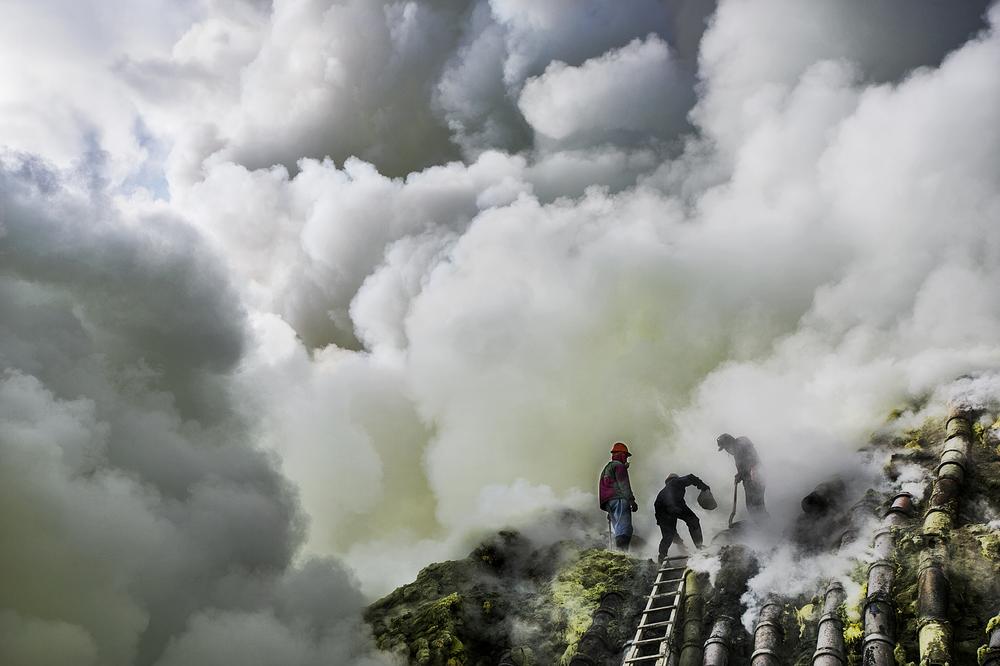
/Gembong Nusantara/Al Jazeera
Miners put ceramic pipes on vents where sulphur gases come out.
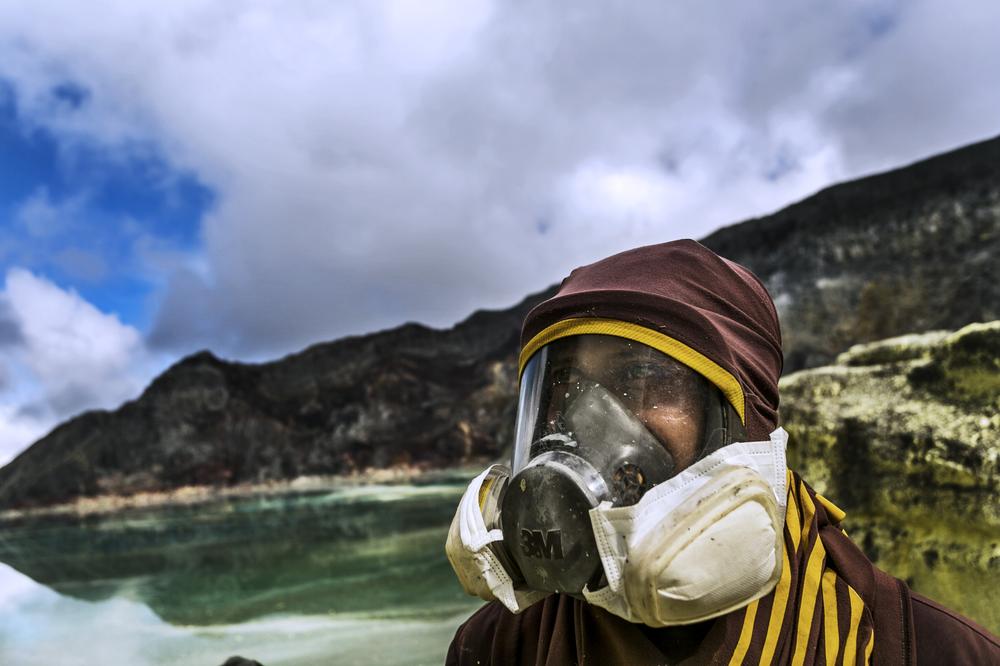
/Gembong Nusantara/Al Jazeera
A sulphur miner wears a full-face gas mask. Due to the hostile environment, full body cover is recommended for miners.

/Gembong Nusantara/Al Jazeera
Sulphur miners carrying a fully loaded basket with sulphur chunks climb up Ijen crater.
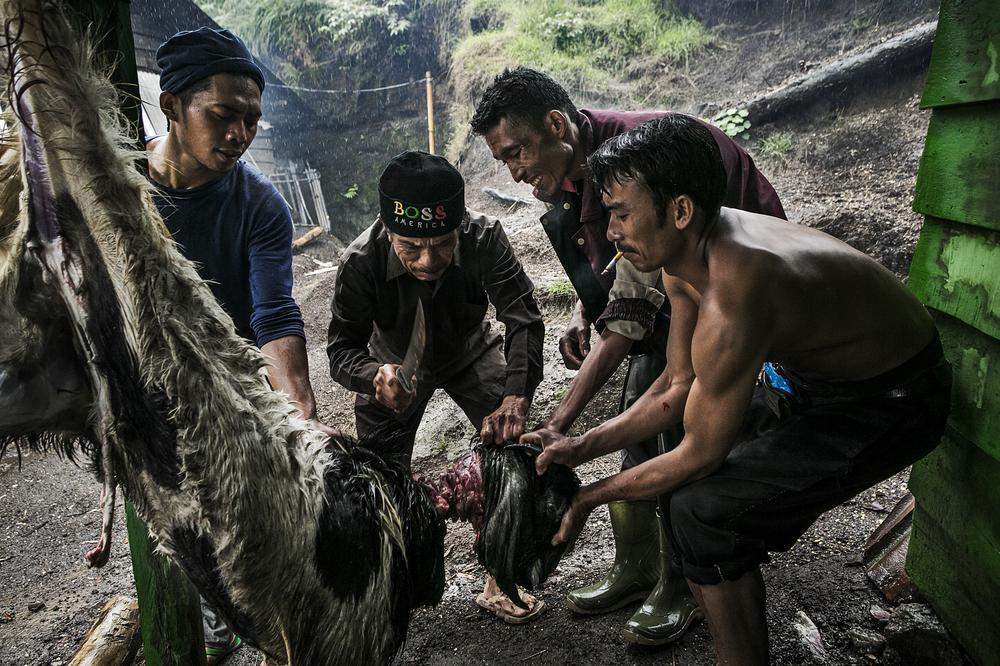
/Gembong Nusantara/Al Jazeera
Miners slaughter a goat as they prepare for an annual sacrificial ritual in the Ijen sulfur crater. The ritual began in 1976 after a tragedy that killed four miners.
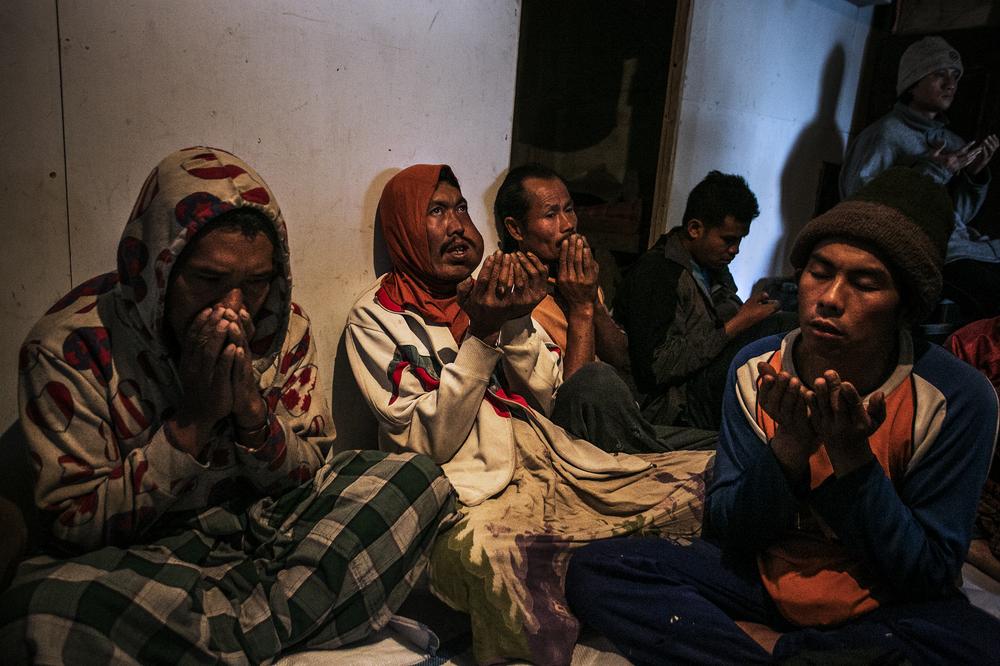
/Gembong Nusantara/Al Jazeera
Miners pray together for salvation during the ritual, in a cabin near the crater.
/Gembong Nusantara/Al Jazeera
Every mid-December, miners offer one goat's head as part of the salvation ritual. The miners' company covers the expenses.
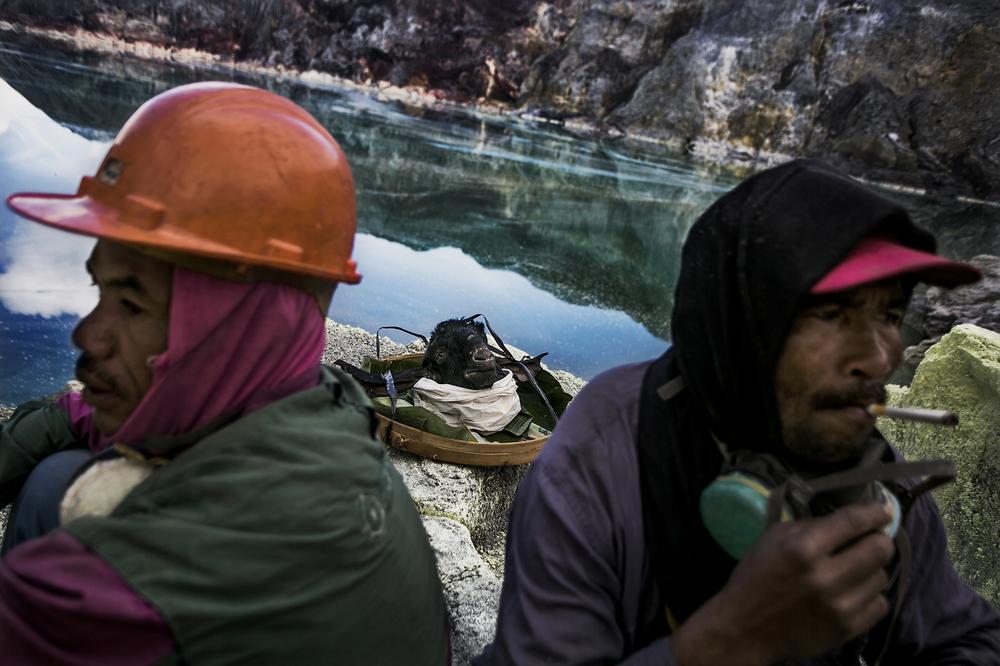
/Gembong Nusantara/Al Jazeera
The offering is put on a lakeside rock as miners wait to perform the sacrificial ritual. The water of the lake has the same acidic level as car batteries.

/Gembong Nusantara/Al Jazeera
Miners bring a goat head to bury in the sulphur pipes as part of the annual ritual.
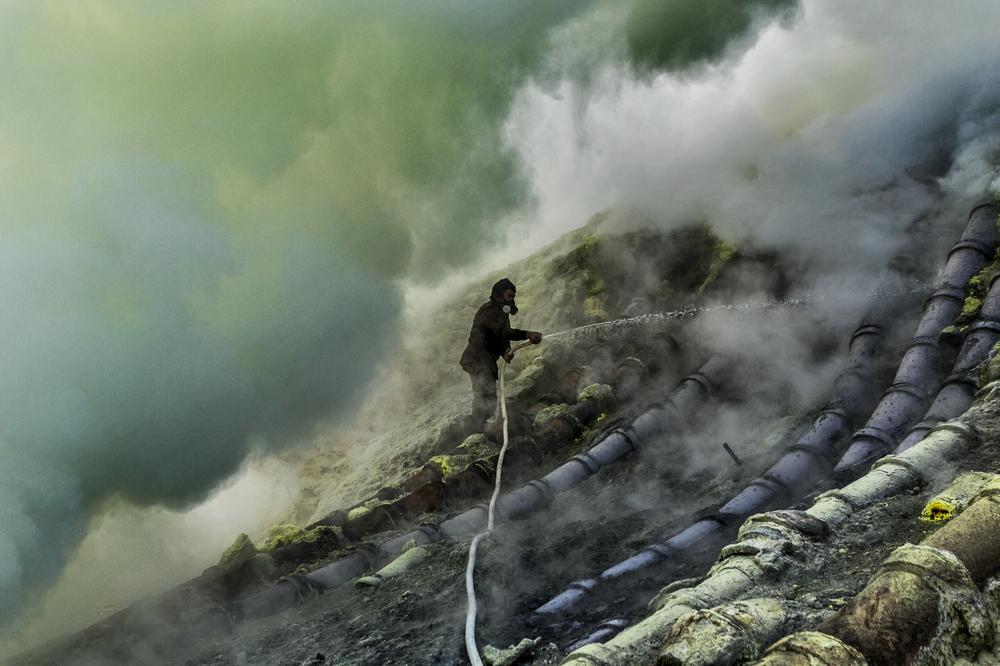
/Gembong Nusantara/Al Jazeera
A miner sprays water onto sulfur pipes as he prepares the area for the offering.

/Gembong Nusantara/Al Jazeera
Sulphur miners work at Ijen crater after the ritual.
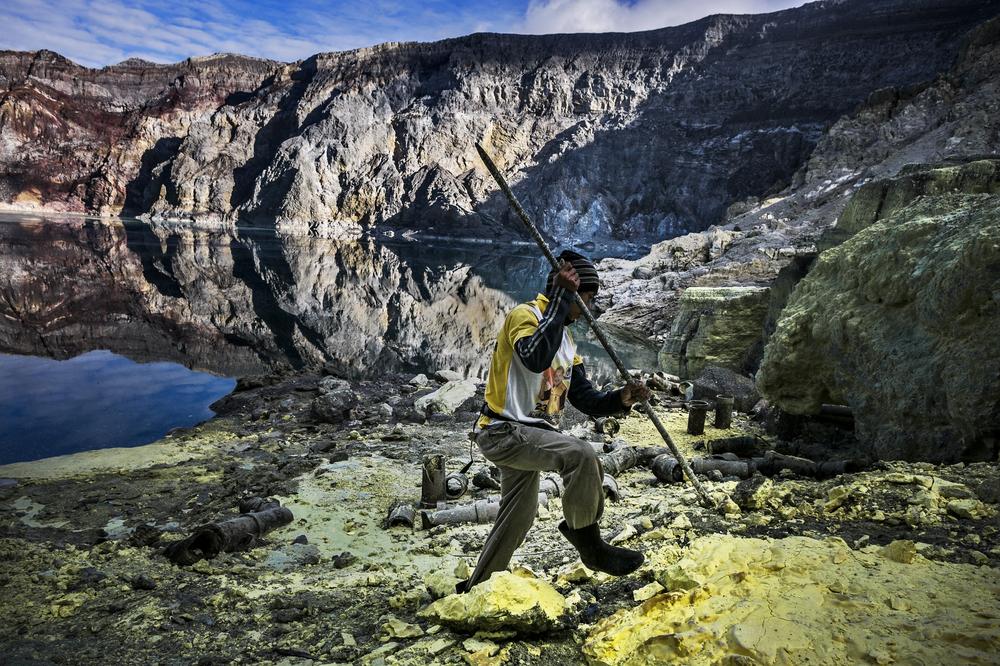
/Gembong Nusantara/Al Jazeera
A miner extracts sulphur at the Ijen crater lakeside.
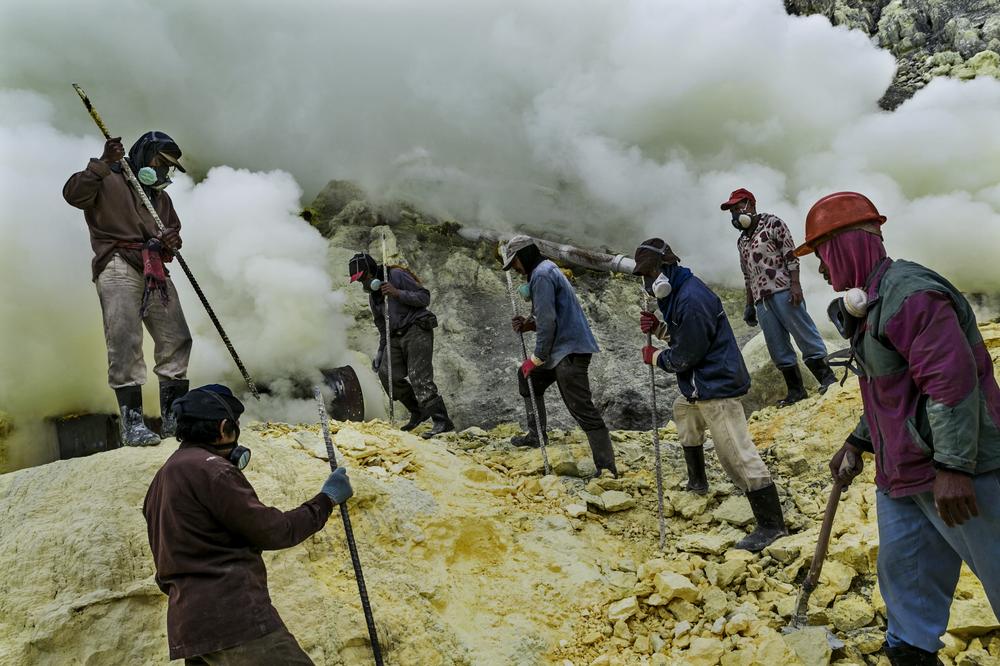
/Gembong Nusantara/Al Jazeera
Miners extract sulphur using the most basic tools. For every kilogram they mine they get paid seven cents.
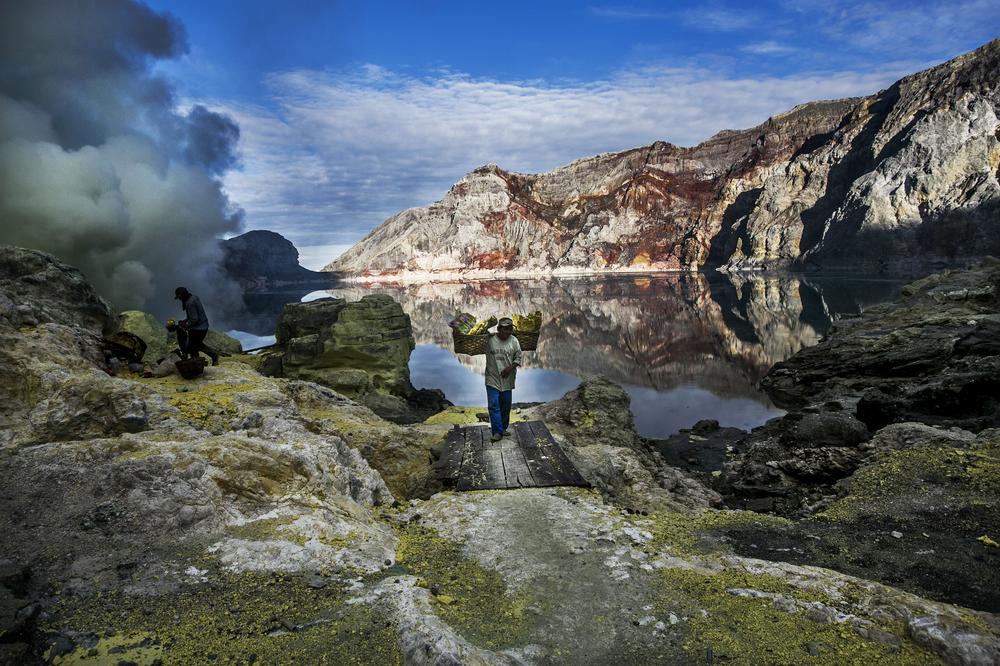
/Gembong Nusantara/Al Jazeera
A miner holds two baskets with sulphur. In one day a miner can carry out around 100 kilograms of sulphur.
Κυριακή 12 Ιανουαρίου 2014
NASA rover’s tracks on Mars
NASA rover’s tracks on Mars
Enhanced color image showing where Curiosity rover zigzagged to avoid obstacles as it made its way across the primeval red desert sands of Mars.

View larger. | Two parallel tracks left by the wheels of NASA’s Curiosity Mars rover cross rugged ground in this portion of a Dec. 11, 2013, observation by the High Resolution Imaging Science Experiment (HiRISE) camera on NASA’s Mars Reconnaissance Orbiter. The rover itself does not appear in this part of the HiRISE observation.
From the time it landed on Mars on August 5, 2012 – until a Mars orbiter captured this image on December 11, 2013 – NASA’s Curiosity had driven about 2.86 miles (4.61 kilometers) on the surface of Mars. This enhanced color image shows where the rover zigzagged to avoid steep slopes and other obstacles as it made its way across Mars’ primeval red desert sands, heading toward the lower slopes of Mount Sharp, the central peak of the Gale Crater, where Curiosity set down. NASA said:
Curiosity is progressing from a bright dust-covered area to a region with a darker surface, where windblown sand scours the surface relatively free of dust. For scale, the two parallel lines of the wheel tracks are about 10 feet (3 meters) apart.
The image came from HiRISE, one of six instruments on NASA’s Mars Reconnaissance Orbiter. Does it thrill you, or bother you, that we humans are making tracks on Mars? If it does bother you at all, remember that Mars isn’t like Earth’s moon. It isn’t airless. Mars has winds and weather and likely soon will cover Curiosity’s tracks with blowing dust.
Bottom line: The HiRISE camera on NASA’s Mars Reconnaissance Orbiter captured a wonderful image of tracks on Mars, made by the Curiosity rover between August 2012 and December 2013.
Εγγραφή σε:
Αναρτήσεις (Atom)



